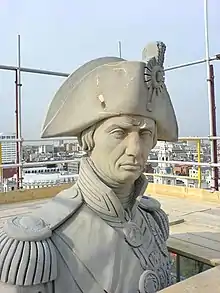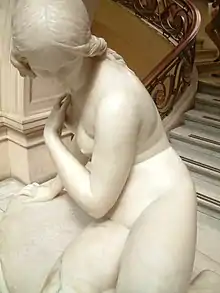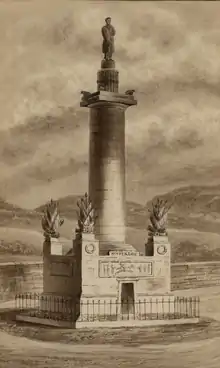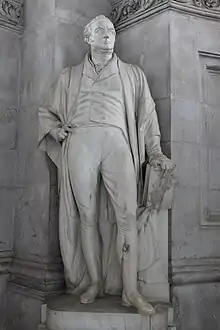Edward Hodges Baily | |
|---|---|
 | |
| Born | 10 March 1788 Bristol, England |
| Died | 22 May 1867 (aged 79) London, England |
| Nationality | British |
| Known for | Sculpture |
| Notable work | Nelson's Column |
| Awards | FRS, Turner Gold Medal |
Edward Hodges Baily RA FRS (10 March 1788 – 22 May 1867; sometimes misspelled Bailey) was a prolific British sculptor responsible for numerous public monuments, portrait busts, statues and exhibition pieces as well as works in silver. He carved friezes for both the Marble Arch and Buckingham Palace in London. His numerous statues of public figures include that of Horatio Nelson on top of Nelson's Column and Charles Grey, 2nd Earl Grey on Grey's Monument in Newcastle upon Tyne. Throughout his career Baily was responsible for creating a number of monuments and memorials for British churches and cathedrals, including several in St Paul's Cathedral.
Biography
Baily was born in 1788 at Downend in Bristol to Martha Hodges (1755-1836) and William Hillier Baily (1763-1834), a woodcutter who specialised in carving ship's figureheads.[1] At the age of fourteen he was placed as an accounts clerk in a mercantile house, where he worked for two years, though he continued to produce wax models and busts, his childhood hobby.[2] In 1804, aged sixteen he abandoned his job and set himself up as a professional wax portraitist.[3] Two Homeric studies, executed for a friend, were shown to the sculptor John Flaxman who was so impressed, that in 1807, he accepted Baily as a pupil in his London studio and subsequently employed him as an assistant.[1] In 1808 Baily won the silver medal of the Society of Arts for a plaster figure of Laocoön and the next year entered the Royal Academy Schools.[3][4] At the academy he won a silver medal in 1809 and in 1811 he gained their gold medal for a model of Hercules restoring Alcestis to Admetus, and soon after exhibited Apollo discharging his Arrows against the Greeks and Hercules casting Lichas into the Sea.[3][4]

From 1816 to 1846 Baily was the Chief Modeller for Rundell, Bridge and Rundell, goldsmiths to the royal family, where he was responsible for creating the Doncaster Cup trophy in 1843 and the Ascot Gold Cup in 1844.[3] Baily also produced designs for the silversmith Paul Storr.[1] For a soup tureen commission in 1821, Baily designed a pair of ornamental handles which became the basis of his large scale marble sculpture Eve at the Fountain, which was acquired by the Bristol Literary Institute and is now in the Bristol Museum & Art Gallery.[3] Widely reproduced at reduced sizes in both Parian ware and bronze, the work was among the most popular individual sculptures in Britain at the time.[1] Baily returned to Eve as a subject in 1842 with the work Eve listening to the Voice.[5] Baily was elected an Associate member of the Royal Academy in 1817 and, on the strength of Eve at the Fountain, a full Academician in 1821.[4][5]
From the 1820s until 1858 Baily had a series of high-profile public commissions and was also responsible for numerous portrait busts, statues and exhibition pieces.[6] He carved the bas-reliefs on the facade of the Masonic Hall on Park Street in Bristol and those on the south side of the Marble Arch in Hyde Park in 1826.[3] When changes were made to the size and design of the Marble Arch, a number of friezes that Baily had carved were considered surplus to requirements but were installed on the facade of Buckingham Palace.[7] He also designd the models of the stone figures installed on the pediment of Buckingham Palace when the building was enlarged and carved the frieze Britannia Rewarding Arts and Sciences for the Palace's throne room.[1] He created the prominent statue of Horatio Nelson for the top of Nelson's Column, in Trafalgar Square.[4] For the facade of the National Gallery facing onto Trafalgar Square he created a series of statues and friezes.[3]

Baily exhibited at the Royal Academy regularly from 1810 to 1862 and at the British Institution from 1812 to 1840.[3] His exhibition pieces often represented aspects of family life with titles such as Maternal Affection and Mother and Child.[6] For Saint Stephen's Hall in the Palace of Westminster he created statues of Charles James Fox and Lord Mansfield.[6] Subjects of his portrait busts included the Duke of Wellington, his mentor John Flaxman and Lord Byron.[6] Several of his designs for monuments were cast as small scales bronzes for the domestic retail market, notably his equestrian statue of George IV.[3]
Financial insecurity was a recurring theme in Baily's life. He was first declared bankrupt in 1831, and again in 1838. On the first occasion questions were asked in Parliament on his behalf because his financial distress had resulted from delays in receiving payment for sculptures at Buckingham Palace.[1] Fortunately his appeals to the Royal Academy for financial assistance, were successful in the 1830s, as again in the 1860s, when they provided him with a pension of £200 a year as an honorary retired Academician.[1] Baily's election as a fellow of the Royal Society (FRS) came in 1842. Among his final works was the design for the Turner medal in 1857, the Royal Academy's award for landscape painting.[1]
Baily married Elizabeth Wardley (1786-1836) in Bristol during 1806 and the couple had four children.[1] Their daughter, Caroline, married Edgar George Papworth Senior one of Baily's assistants.[1] Among his other assistants and pupils were John Henry Foley, Musgrave Watson, Joseph Durham, Edward Bowring Stephens and William Theed.[1][8] Baily's nephew was William Hellier Baily, the paleontologist.
Baily died at 99 Devonshire Road, Holloway in north London on 22 May 1867 and is buried in the city's Highgate Cemetery.[9]
Selected public works
1815–1829
| Image | Title / subject | Location and coordinates |
Date | Type | Material | Dimensions | Designation | Wikidata | Notes |
|---|---|---|---|---|---|---|---|---|---|
 |
Memorial to Calverly Bewick | Newcastle Cathedral | After 1815 | Sculpture group on plinth | Marble | Grade I | With William Theed[10][11] | ||
 More images |
William Ponsonby | Crypt of St Paul's Cathedral, London | 1820 | Sculpture group on plinth | Marble | [12][13] | |||
 |
Eve at the Fountain | Bristol Museum and Art Gallery | 1822 | Statue | Marble | A plaster version is held by the Victoria and Albert Museum[14] | |||
 |
Bristol with Minerva and Apollo | Portico of 17 Park Street, Bristol | 1824 | Curved relief frieze | Carrara marble | 820cm long by 80cm high | Grade II* | Q17553095 | Architect;- Charles Robert Cockerell.[15] |
 |
Memorial to Thomas Parry | St. George's Cathedral, Chennai | 1824 | Relief sculpture | Marble | [16] | |||
 More images |
Henry Fuseli | National Portrait Gallery, London | 1824 | Bust | Marble | 570mm x 285mm | [17] | ||
 More images |
John Jervis, 1st Earl of St Vincent | Crypt of St Paul's Cathedral, London | 1826 | Statue | Marble | [12][18] | |||
.jpg.webp) More images |
Battle of St Vincent | Regent's Place Plaza, Camden, London | c. 1826 | Frieze | Marble | [19] | |||
 |
Memorial to Bishop George Pelham | St Mary's Church, Buckden, Cambridgeshire | 1827 | Sculpture | Marble | Grade I | [20] | ||
 |
Monument to Thomas Picton | Picton Terrace, Carmarthen | 1828 | Statue | Bronze | Statue; 9ft 6in | Monument was dismantled in 1846[8][21][22] | ||
.jpg.webp) |
The Death of General Sir Thomas Picton at Waterloo | Carmarthenshire County Museum, Carmarthen | 1828 | Relief frieze | Stone | Created for the Picton Monument dismantled in 1846[8][22] | |||
 More images |
Valour and Virtue and Peace and Plenty | South face of Marble Arch, London | 1828 | Two reliefs | Marble | 150cm square | Grade I | Q845529 | [7][23] |
.jpg.webp) More images |
Pallas Athene | Athenaeum Club, London | 1829 | Gilded statue | Grade I | Q89271625 | Architect, Decimus Burton[24] |
1830–1839
| Image | Title / subject | Location and coordinates |
Date | Type | Material | Dimensions | Designation | Wikidata | Notes |
|---|---|---|---|---|---|---|---|---|---|
 |
Sir Thomas Lawrence | National Portrait Gallery, London | 1830 | Bust | Marble | 700mm x 420mm | [25] | ||
 More images |
Pulteney Malcolm | Crypt of St Paul's Cathedral, London | 1832 | Statue | Marble | [12][26] | |||
 More images |
Maternal Affection | Victoria and Albert Museum | 1837 | Sculpture group | Marble | 94cm | [14] | ||
 More images |
George Wyndham, 3rd Earl of Egremont | Church of St Mary, Petworth, West Sussex | After 1837 | Seated statue on pedestal | Marble | Grade I | [1][27] | ||
 More images |
Charles Grey, 2nd Earl Grey | Grey's Monument, Newcastle upon Tyne | 1838 | Statue | Marble | Grade I | Q5608058 | [8][28] | |
 More images |
Thomas Telford | Westminster Abbey, London | 1839 | Statue on pedestal | Marble | [29] | |||
 More images |
Horatio Nelson | Nelson's Column, London | 1839-42 | Statue | Craigleith stone | Grade I | Q2447876 | [8][30] |
1840–1849
| Image | Title / subject | Location and coordinates |
Date | Type | Material | Dimensions | Designation | Wikidata | Notes |
|---|---|---|---|---|---|---|---|---|---|
 More images |
Henry Vassall-Fox, 3rd Baron Holland | Westminster Abbey, London | After 1840 | Bust on monument with figures at base | Marble | [31] | |||
 |
Albert, Prince Consort | Victoria and Albert Museum | 1841 | Bust | Marble | 80cm | Commissioned, and rejected, by Queen Victoria for portraying Albert as too old[14] | ||
 More images |
Astley Cooper | St Paul's Cathedral, London | 1842 | Statue | Marble | [12][32] | |||
 More images |
Richard Bourke | Sydney, Australia | 1842 | Statue on pedestal | Bronze & stone | [33] | |||
 More images |
Eve listening to Adam | Victoria and Albert Museum | 1842 | Statue | Marble | 96.5cm | Also known as Eve listening to the Voice[14] | ||
 More images |
Dr Isaac Watts | Abney Park Cemetery, Stoke Newington, London | 1845 | Statue on pedestal | Stone | Grade II | Q26528763 | [34] | |
 More images |
David Hare | Hare School, Kolkata | 1845 | Statue on pedestal | Marble | KMC Grade 1 | Q68148800 | [16] | |
 |
Charles Metcalfe, 1st Baron Metcalfe | St. William Grant Park, Kingston, Jamaica | After 1846 | Statue on pedestal | Stone | [16] |
1850 and later
| Image | Title / subject | Location and coordinates |
Date | Type | Material | Dimensions | Designation | Wikidata | Notes |
|---|---|---|---|---|---|---|---|---|---|
 |
Nicholas Conyngham Tindal | Tindal Square, Chelmsford, Essex | 1850 | Seated statue on pedestal | Bronze & stone | Grade II | Q26391312 | [8][35] | |
| Thomas Fleming | Manchester Cathedral | 1851 | Statue on pedestal | Marble | Grade I | [36][37] | |||
 More images |
Statue of Robert Peel | Market Place, Bury, Greater Manchester | 1852 | Statue on pedestal with relief panels | Bronze & granite | Grade II | Q7160232 | [8][38] | |
 More images |
George Stephenson | National Railway Museum, York | 1852 | Statue on pedestal | Marble & stone | Relocated from Euston Station, London[39] | |||
_(14780383854).jpg.webp) |
Lord Mansfield | St Stephen's Hall, Westminster, London | 1855 | Statue on pedestal | Marble | [40] | |||
| Charles James Fox | St Stephen's Hall, Palace of Westminster, London | 1856 | Statue on pedestal | Marble | [41][42] |
Church monuments and memorials
Throughout his career Baily was responsible for creating a number of monuments and memorials for British churches and cathedrals. Examples include

- A tablet with two marble full-length angels, to Samuel Paynter, of Richmond at St Mary Magdalene, Richmond.
- Several memorials in the Church of St Nicholas, Lintn Hill, Maidstone, at St James, Uttoxeter Road, Stoke-on-Trent and at St John the Baptist, Devizes[43][44][45]
- Memorial with kneeling female figure, Church of the Holy Trinity, Ardington, Oxfordshire[46]
- Memorials to Peter Denys, died 1816, and to Lady Charlotte Denys, died 1835, Church of St Mary, Easton Neston, Northamptonshire[47]
- Two memorials, to Benjamin Newcombe (1818) and to George Gostling (1854) in Church of St John the Baptist, Egham High Street[48]
- Memorial plaque to A Walker Heneage, died 1828, in the Church of St Swithin, Compton Bassett[49]
- Memorial tablet for Elizabeth Bell (1829), Church of St James, Lincolnshire[50]
- Large memorial to J. Spearing, died 1831, Church of St Mary, Potterne, Wiltshire[51]
- Memorials to John Ogle, died 1831, and to Sara Ogle, died 1846, in the Church of Saint Mary Magdalene, Whalton[52]
- Memorial, with medallion bust, to Bishop John Jebb, died 1833, in the Church of the Holy Trinity, Clapham Common,London[53]
- A chancel wall plaque 1836, Church of St Andrew, Heddington, Wiltshire[54]
- Wall monument to Thomas Botfield, died 1843, Church of St Michael, Hopton Wafers, Shropshire[55]
- A memorial with carved figure, 1846, Church of St Mary, Hertfordshire[56]
- A sculpture group memorial to John Thackeray, died 1851, Church of St Mary the Virgin, Lewisham High Street, London[57]
Other works
- The Victoria and Albert Museum in London has Baily's Marius among the ruins of Carthage, a plaster model for a full-size marble sculpture he exhibited at the Royal Academy in 1833. The museum also has a marble bust by Baily of an unidentified man from 1850.[14]
- Lord Byron, 1826, Harrow School; and Newstead Abbey, Nottinghamshire[1]
- Michael Faraday, 1830, University Museum, Oxford[1]
- Philip John Miles, Holy Trinity, Abbots Leigh
- Richard Owen, 1846, Royal College of Surgeons[1]
- Sir John Herschel, 1850, St. John's College, Cambridge[1]
- Busts of Thomas Bewick and Sir James Knott – Literary and Philosophical Society of Newcastle upon Tyne
- Charles Metcalfe, 1st Baron Metcalfe, a marble bust from 1844 in the Victoria Memorial, Kolkata[16]
- Justice – Old Council House, Bristol[58]
- Five statues in niches representing Christ and the Evangelists, after originals by Bertel Thorvaldsen, in the Church of St Margaret at Grittleton, Wiltshire.[59]
- Marble bust of John Flaxman in the Royal Academy with a copy, c. 1836 in Coade stone in the British Museum.[60]
References
- 1 2 3 4 5 6 7 8 9 10 11 12 13 14 15 16 Katharine Eustice (8 April 2021). "Baily, Edward Hodges". Oxford Dictionary of National Biography (online ed.). Oxford University Press. doi:10.1093/ref:odnb/1076. Retrieved 14 July 2022. (Subscription or UK public library membership required.)
- ↑ Rupert Gunnis. Dictionary of British Sculptors 1660–1851. The Abbey Library.
- 1 2 3 4 5 6 7 8 9 James Mackay (1977). The Dictionary of Western Sculptors in Bronze. Antique Collectors' Club. ISBN 0902028553.
- 1 2 3 4 Chisholm, Hugh, ed. (1911). . Encyclopædia Britannica. Vol. 3 (11th ed.). Cambridge University Press. p. 221.
- 1 2 "Eve listening to the Voice". Victoria & Albert Museum. Retrieved 14 July 2022.
- 1 2 3 4 Ernest Radford (1885). . In Stephen, Leslie (ed.). Dictionary of National Biography. Vol. 2. London: Smith, Elder & Co. p. 427.
- 1 2 Historic England. "The Marble Arch (1239534)". National Heritage List for England. Retrieved 20 June 2022.
- 1 2 3 4 5 6 7 Jo Darke (1991). The Monument Guide to England and Wales. Macdonald Illustrated. ISBN 0-356-17609-6.
- ↑ Frederick Teague Cansick (1872). The Monumental Inscriptions of Middlesex Vol 2. J Russell Smith. p. 128. Retrieved 9 April 2021.
- ↑ Historic England. "Cathedral of St Nicholas (1355309)". National Heritage List for England. Retrieved 11 July 2022.
- ↑ "Memorial to Calverly Berwick". The Courtauld Institute of Art. Retrieved 15 July 2022.
- 1 2 3 4 "St Paul's Cathedral". Church Monument Gazetter. Retrieved 4 March 2022.
- ↑ "Monument to Sir William Ponsonby". The Courtauld Institute of Art. Retrieved 15 July 2022.
- 1 2 3 4 5 Diane Bilbey with Marjorie Trusted (2002). British Sculpture 1470 to 2000 A Concise Catalogue of the Collection at the Victoria and Albert Museum. V&A Publications. ISBN 1851773959.
- ↑ Historic England. "Freemasons' Hall and Attached Cast Iron Railings (1282205)". National Heritage List for England. Retrieved 20 June 2022.
- 1 2 3 4 Mary Ann Steggles & Richard Barnes (2011). British Sculpture in India: New Views & Old Memories. Frontier Publishing. ISBN 9781872914411.
- ↑ "Henry Fuseli". National Portrait Gallery. Retrieved 3 October 2023.
- ↑ "Statue of John, Earl of St Vincent". The Courtauld Institute of Art. Retrieved 15 July 2022.
- ↑ "The Battle of St Vincent Frieze". Art UK. Retrieved 23 June 2022.
- ↑ Historic England. "Parish Church of St Mary (1330416)". National Heritage List for England. Retrieved 10 July 2022.
- ↑ "War Memorials Register: Sir T Picton". Imperial War Museum. Retrieved 21 June 2022.
- 1 2 Cadw. "Picton Monument (9503)". National Historic Assets of Wales. Retrieved 23 June 2022.
- ↑ Philip Ward-Jackson (2011). Public Sculpture of Britain Volume 1: Public Sculpture of Historic Westminster. Liverpool University Press / Public Monuments & Sculpture Association. ISBN 978-1-84631-662-3.
- ↑ Historic England. "The Athenaeum (1225842)". National Heritage List for England. Retrieved 21 June 2022.
- ↑ "Sir Thomas Lawrence". National Portrait Gallery. Retrieved 3 October 2023.
- ↑ "Monument to Sir Pulteney Malcolm". The Courtauld Institute of Art. Retrieved 15 July 2022.
- ↑ Historic England. "The Parish Church of St Mary (1224199)". National Heritage List for England. Retrieved 22 June 2022.
- ↑ Historic England. "Earl Grey Monument (1329931)". National Heritage List for England. Retrieved 21 June 2022.
- ↑ "Thomas Telford". Westminster Abbey. Retrieved 8 August 2022.
- ↑ Historic England. "The Nelson Monument (Nelson's Column) (1276052)". National Heritage List for England. Retrieved 20 June 2022.
- ↑ "Charles James Fox and Henry V. Fox, Lord Holland". Westminster Abbey. Retrieved 27 September 2022.
- ↑ "Monument to Sir Astley Paston Cooper". The Courtauld Institute of Art. Retrieved 15 July 2022.
- ↑ "Dictionary of Sydney: Sir Richard Bourke statue". State Library of New South Wales. Retrieved 22 June 2022.
- ↑ Historic England. "Monument to Isaac Watts in Abney Park Cemetery (1235434)". National Heritage List for England. Retrieved 21 June 2022.
- ↑ Historic England. "Statue of Sir Nicholas Conyngham Tindal (1099160)". National Heritage List for England. Retrieved 22 June 2022.
- ↑ Historic England. "Cathedral Church of St Mary (1218041)". National Heritage List for England. Retrieved 22 June 2022.
- ↑ University of Glasgow History of Art / HATII (2011). "Statue, in marble, of the late Thomas Fleming, Esq of Manchester". Mapping the Practice and Profession of Sculpture in Britain & Ireland 1851–1951. Retrieved 22 June 2022.
- ↑ Historic England. "Statue of Sir Robert Peel (1356807)". National Heritage List for England. Retrieved 20 June 2022.
- ↑ "Marble statue of George Stephenson, 1852". Science Museum Group. Retrieved 22 June 2022.
- ↑ "William Murray 1st Earl of Mansfield 1705-99 Speaker 1760 1770-1". UK Parliament. Retrieved 23 June 2022.
- ↑ "Charles James Fox 1749-1806 Whig Reformer". UK Parliament. Retrieved 23 June 2022.
- ↑ Malcolm Hay & Jacqueline Riding (1996). Art in Parliament - The Permanent Collection of the House of Commons. Jarrod Publishing & The Palace of Westminster. ISBN 0-7117-0898-3.
- ↑ Historic England. "Church of St Nicholas (1250235)". National Heritage List for England. Retrieved 20 June 2022.
- ↑ Historic England. "Church of St James (1210730)". National Heritage List for England. Retrieved 20 June 2022.
- ↑ Historic England. "Church of St John the Baptist (1262359)". National Heritage List for England. Retrieved 20 June 2022.
- ↑ Historic England. "Church of Holy Trinity (1048189)". National Heritage List for England. Retrieved 20 June 2022.
- ↑ Historic England. "Church of St Mary (1189210)". National Heritage List for England. Retrieved 11 July 2022.
- ↑ Historic England. "Church of Saint John the Baptist (1189321)". National Heritage List for England. Retrieved 11 July 2022.
- ↑ Historic England. "Church of St Swithin (1363781)". National Heritage List for England. Retrieved 11 July 2022.
- ↑ Historic England. "Church of St James (1379386)". National Heritage List for England. Retrieved 11 July 2022.
- ↑ Historic England. "Church of St Mary (1258968)". National Heritage List for England. Retrieved 11 July 2022.
- ↑ Historic England. "Church of Saint Mary Magdalene (1247805)". National Heritage List for England. Retrieved 11 July 2022.
- ↑ Historic England. "Church of Holy Trinity (1080491)". National Heritage List for England. Retrieved 11 July 2022.
- ↑ Historic England. "Church of St Andrew (1261202)". National Heritage List for England. Retrieved 20 June 2022.
- ↑ Historic England. "Church of St Michael (1383537)". National Heritage List for England. Retrieved 20 June 2022.
- ↑ Historic England. "Church of St Mary (1347611)". National Heritage List for England. Retrieved 20 June 2022.
- ↑ Historic England. "Church of St Mary the Virgin (1193297)". National Heritage List for England. Retrieved 11 July 2022.
- ↑ Historic England. "The Old Council House & attached front gates (1207433)". National Heritage List for England. Retrieved 20 June 2022.
- ↑ Historic England. "Church of St Margaret (1022289)". National Heritage List for England. Retrieved 20 June 2022.
- ↑ Aileen Dawson (1999). Portrait Sculpture A Catalogue of the British Museum collection c. 1675-1975. British Museum Press. ISBN 0714105988.
Further reading
- Jordan, Caroline (June 2006), ""The very spirit of purity and chastity": Eve at the Fountain by Edward Hodges Baily", Sculpture Journal, 15 (1): 19–35, doi:10.3828/sj.15.1.2